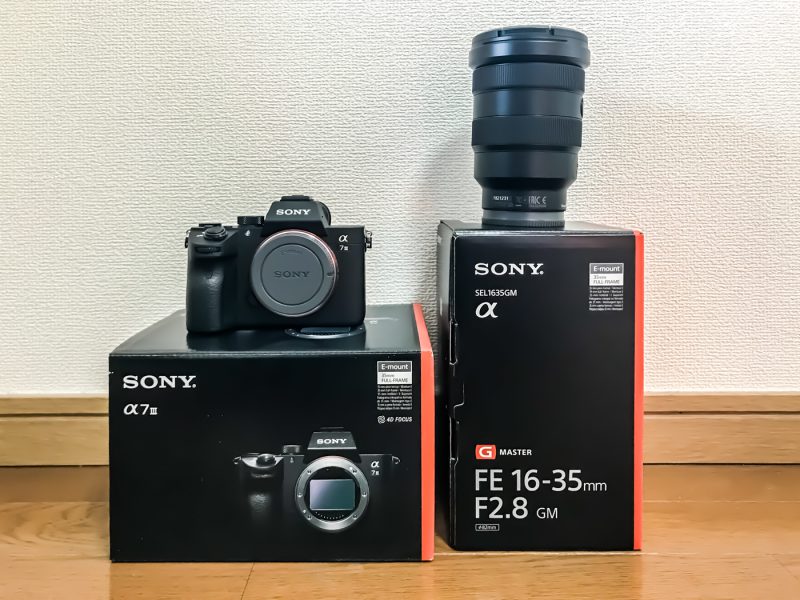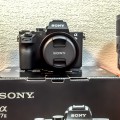[Introduction]
I have run this blog as a travel blog with lots of photos, so basically I don’t deal with photo equipment such as camera body and lens. However, since I have changed my main camera setting, I will write about it just for reference.
[Main Part]
Change from “α7 II & SEL1635Z” to “α7 III & SEL1635GM”
To tell the conclusion first, I replaced “α7 II”, which I used for two years, with “α7 III”, a newly released camera and the successor of “α7 II”. In addition, I sold “SEL1635Z” and bought “SEL1635GM”.
In short, I changed my camera setting from this one (“α7 II & SEL1635Z”)
to this one (“α7 III & SEL1635GM”)!
By the way, here is the article, which I wrote when I bought “α7 II” two year ago.
“Switching my camera from APS-C size to Full-size (SONY α7 II)”
The above article has received the 5th most access (more than 10,000 PV) in my blog so far. It seems there is a demand in such an article, so I will try to catch lightning in a bottle 🙂 The following sections describes why I changed camera body and lens respectively.
Why I changed to “α7 III” from “α7 II”
To begin with, camera body.
First of all, I will give my impression of “α7 II”, which I used for two years. I was quite satisfied with it as my first full-frame camera. In terms of the balance between the price and the spec, “α7 II” was ideal for me and I would like to give it 90-95 points out of 100. When the successor “α7 III” was newly released, I decided to replace “α7 II” with “α7 III” mainly for the following two reasons.
Reason 1: Silent Shooting
One of the few dissatisfactions I had in “α7 II” was that it was not able to take silent shooting. Now most of the SONY millor-less cameras, including APS-C format, allow silent shooting, but “α7 II” does not have such a function. As I mainly use the camera during travel, I somethimes encounter inconvenient situations.
For example, when I visit museums in foreign countries, it is usually allowed to take photos as long as I don’t use flash. Considering other visitors, I would like to take photos with silent shooting.
(At National Palace Museum in Taipei: related article)
I hesitate to take photos at religious facilities without silent shooting.
(At Little India in Singapore: related article)
I sometimes feel I wish my camera had silent shooting function when I visit fancy restaurants.
(At “Kitchen Hida” in Hida Takayama: related article)
Another case is when I am in the plane.
(In the airplane of Hong Kong Airlines: related article)
Thus, when I knew “α7 III” has silent shooting function, I was motovated to buy it.
Reason 2: Longer Battery Life
Another major trigger was that “α7 III” can use a NP-FZ100 battery with approximately 2.2 times as much capacity as the previous model. When I went on travel with “α7 II”, I usually bring four batteries. If I take photos all the day (around 1,000 pictures), I usually used up three batteries.
What’s the matter worse, when I travel in cold climates, I often use up all of four batteries.
(At Shirakawa-go in winter: related article)
(At Hakodate in winter: related article)
Therefore, I was delighted to know that “α7 III” has more powerful battery.
Other improvements
Other impriovements from “α7 II” to “α7 III” include:
- Newly developed sensor, evolved image processor
- Reducing noise in high-resolution images (- standard ISO range is extended to ISO 100-51200)
- AF performance evolves (- this camera features 693 phase-detection AF points covering approximately 93% of image area plus 425 densely positioned contrast-detection AF points to improve focus)
- Continuous shooting of up to 10 fps and up to approximately 89 compressed RAW images can be captured in one continuous burst
In Sony’s full-frame millar-less cameras, “α9” and “α7R III” are classified as upper models while “α7 III” is considered as basic model. So, “α7 III” does not have some functions which “α9” and “α7R III” have, but I think “α7 III” has good balance between the price and the spec.
Why I changed to “SEL1635GM” from “SEL1635Z”
Next, lens.
I have used “SEL1635” along with “α7 II” and found this lens very useful as a high-performance wide-angle zoom lens. At first, I often used it at 16mm and then found 35mm angle was also good for travel snaps. When I went to travel, I usually brought three lenses and actually most of my photos were taken with “SEL1635Z”.
In such a situation, I replaced it with “SEL1635GM”, which has the same focal length and belongs to “G Master”, SONY’s prime lens series. The biggest difference is maximum aperture: F4 (“SEL1635Z”) vs. F2.8 (“SEL1635GM”). I expect “SEL1635GM” has advantages in the following situations.
Easier Hand-held Photographing a Night-Scene
This is the main reason why I changed from “SEL1635Z” to “SEL1635GM”. When I used “SEL1635Z”, I sometimes felt “I wish I had more brighter lens”.
I use a tripod when necessary, but I would like to take night-scene photos without a tripod as much as possible, considering mobility. Here are some hand-held night-scene photos I took in the past with “SEL1635Z” and I expect these night-scene photos will be improved with “SEL1635Z”.
(At Nikko Station Hotel Classic: related article)
(At Causeway Bay in Hong Kong: related article)
(At Central Park Station in Kaohsiung, Taiwan: related article)
(At Shurijo Castle Park in Okinawa: related article)
(At A Mei Tea House in Jiufen, Taiwan: related article)
(At Kumamoto Castle in Kumamoto: related article)
(At Matsuyama City Station: related article)
(At Fullerton Hotel in Singapore: related article)
(At ION Orchard in Singapore: related article)
(At Times Square in New York: related article)
(At Kiyomizu-dera Temple in Kyoto: related article)
Useful at Aquariums and Museums
Less F value lens is useful when I visit aquariums and museums where the room is relatively dark.
(At Churaumi Aquarium in Okinawa: related article)
(At Ocean Park in Hong Kong: related article)
(At Guang Shan Buddha Museum in Kaohsiung, Taiwan: related article)
(At National Gallery Singapore in Singapore: related article)
Background Bokeh
Shooting up close at F2.8 can produce some extraordinary background bokeh. For example, when I visit restaurants, I sometimes feel I would like to take photos with more background bokeh.
(At Nikko Kanaya Hotel in Nikko: related article)
(At Omi-cho Market in Kanazawa: related article)
Pros and Cons of “SEL1635GM”
Compared with “SEL1635Z” and “SEL1635GM”, I am satisfied with high-resolution of “SEL1635Z” enough, so I guess there is not so much difference between these two lenses in terms of resolution. Therefore, when considering buying either of them, you need to ask yourself whether F2.8 is necessary for your photography style. In addition, you may also have to take into account that “SEL1635GM” is bigger and heavier than “SEL1635Z”. In my case, I need F2.8 aperture and when I checked with “SEL1635GM” at a SONY store before buying it, and found the size and the weight are OK with me, so I decided to replace “SEL1635Z” with “SEL1635GM”.
Try out New Camera and Lens at Tokyo International Forum
As my first photo shooting after I bought “α7 III” and “SEL1635GM”, I went to Tokyo International Forum. When thinking about good locations for photography with wide-angle lens, the first venue that came to my mind was Tokyo International Forum, as there was a soaring lobby. Here are some photos at Tokyo International Forum.
Considering their features, hand-held photographing night-scene would be the best timing when I tied out my new camera and lens, but due to my schedule, I took photos in the day time. Anyway, I was satisfied with its resolution 🙂
[Closing]
That’s it for the article about changing my main camera setting from “α7 II & SEL1635Z” to “α7 III & SEL1635GM”.
Recently I have been spending my spare time on workout at gym, so I have a little bit lost my interests on camera and photography over the past year. However, since I bought my new camera and lens, I have been to motivated to take photos again.
Then, what’s the matter is where to go for my next travel? As you may know if you are a continuous reader of my blog, and as I mentioned in the past article when I bought “α7 II”, Onomichi in Hiroshima prefecture is the memorable spot in my camera history with SONY. So, just like my first travel with “α7 II”, I thought of Onomichi at first.
The past article including the three photos above is: “Revisit Onomichi Part 1: Senkoji Temple and Tenneiji Temple Kaiun-to”
However, JR Onomichi station, which is a gateway to Onomichi, has been under construction and it it said the new station building will be opened in March 2019. If I revisit Onomichi, I would like to see the new station building, so I decided to pass on the idea to visit Onomichi this time.
Then, considering various aspects, I determined to revisit Matsuyama in Ehime prefecture for the first time in one and a half year since “Yuru-chara Grand Prix 2016”.
I have been to Matsuyama in Ehime prefecture five times so far, but there are still new spots I have never been to. For example, Dogo Onsen station was renovated and Starbucks was opened in the station. In addition, Botchan train museum was opened. Above all, I am looking forward to “Dogo ONSENART 2018”, a great art festival held at Dogo Onsen (Dogo Hot Spring). Here is a photo I took when I visited “Dogo Art 2015” three years ago.
So, I am going to Matsuyama in Ehime prefecture this weekend. Once I return from the trip, I will write new articles as the first series with “α7 III & SEL1635GM”. Stay tuned!
[Related Link]
α7 III (Sony Website)
SEL1635GM (SONY Website)
I would appreciate it if you could share my article via the following SNS buttons.


